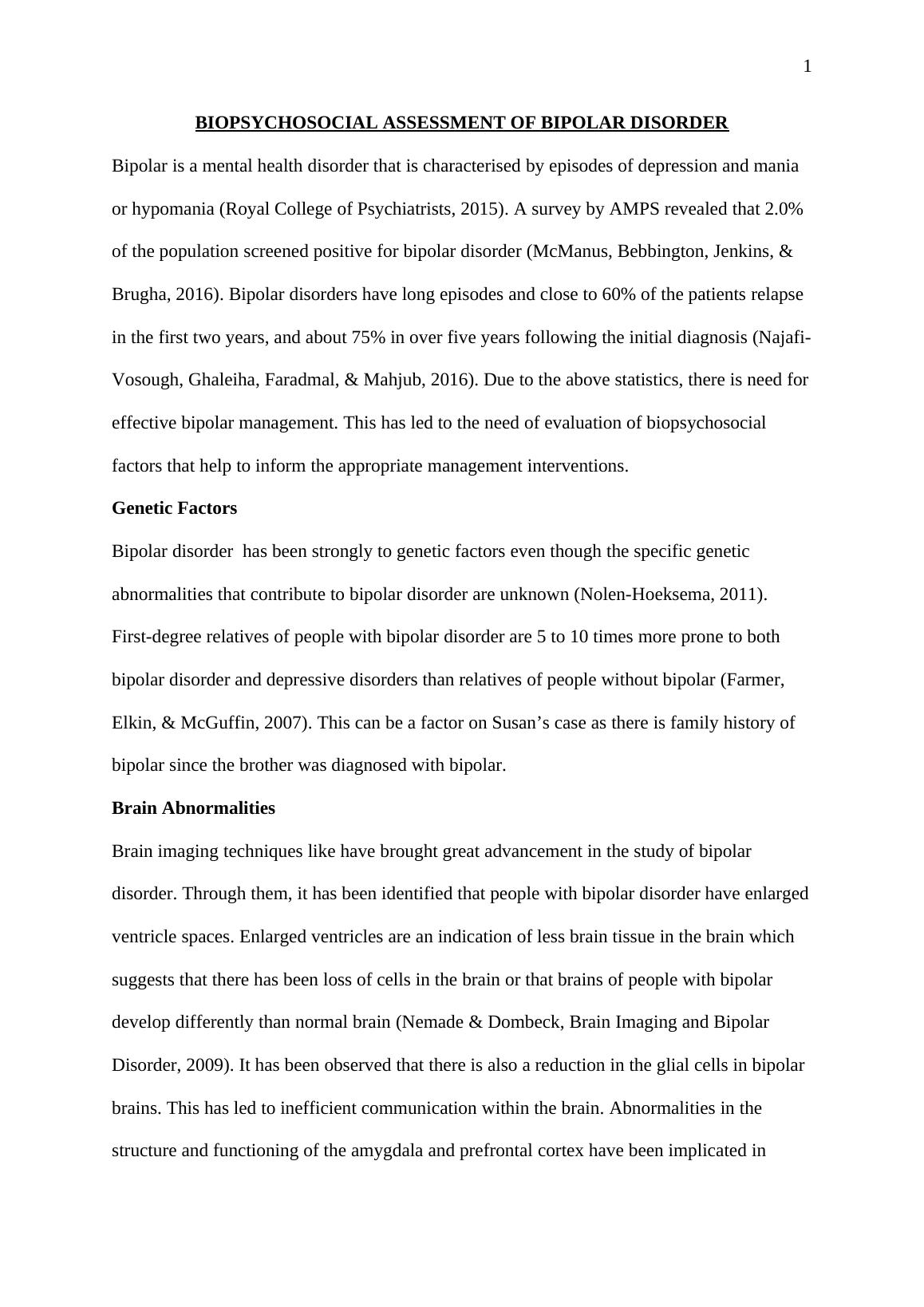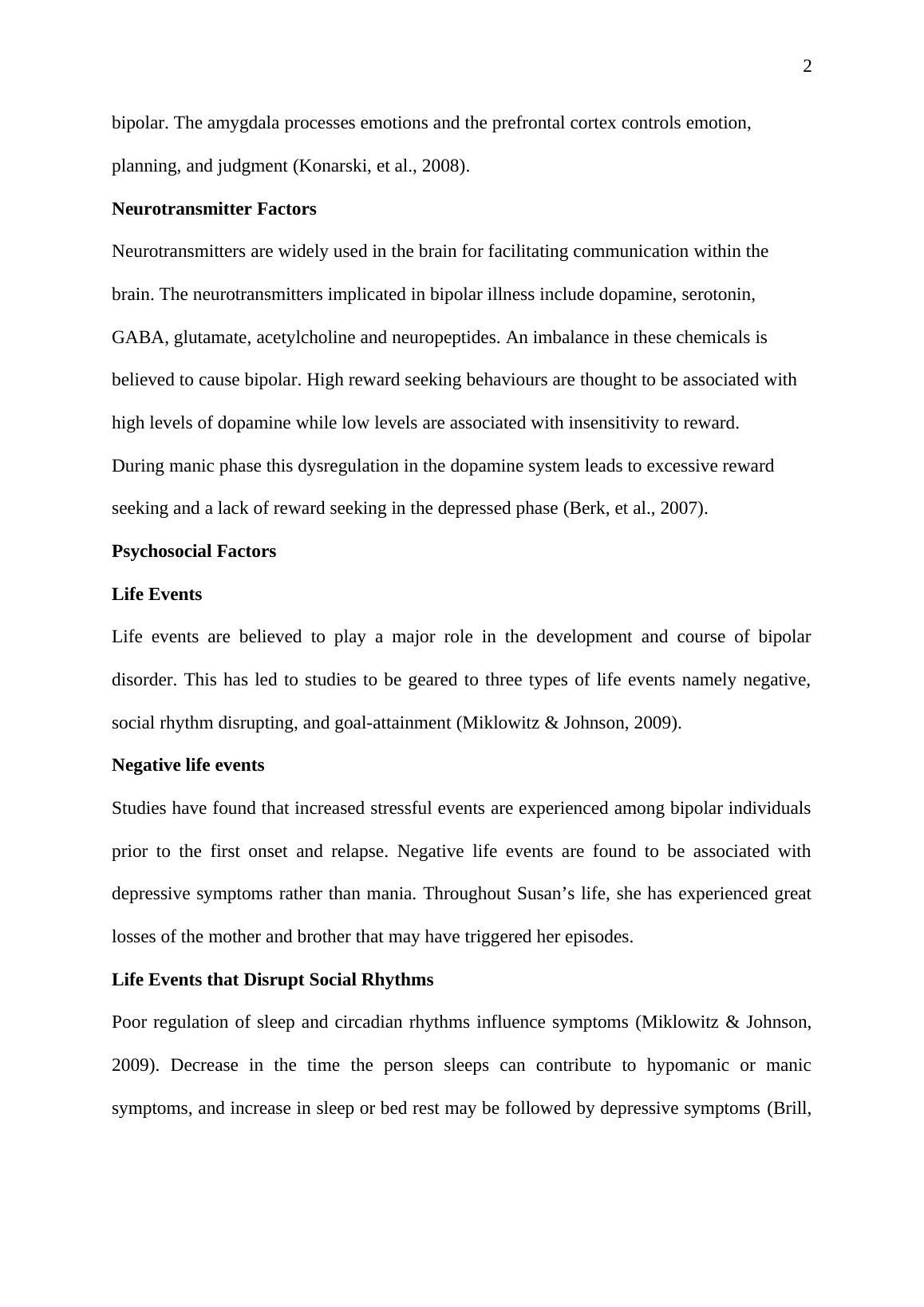The Bipolar Mental Illness Onset study - 2809NRS
Added on 2020-03-04
10 Pages3027 Words132 Views
1BIOPSYCHOSOCIAL ASSESSMENT OF BIPOLAR DISORDERBipolar is a mental health disorder that is characterised by episodes of depression and mania or hypomania [ CITATION Roy15 \l 1033 ]. A survey by AMPS revealed that 2.0% of the population screened positive for bipolar disorder [ CITATION McM16 \l 1033 ]. Bipolar disorders have long episodes and close to 60% of the patients relapse in the first two years, and about 75% in over five years following the initial diagnosis[ CITATION Naj16 \l 1033 ]. Due to the above statistics, there is need for effective bipolar management. This has led to theneed of evaluation of biopsychosocial factors that help to inform the appropriate managementinterventions. Genetic FactorsBipolar disorder has been strongly to genetic factors even though the specific genetic abnormalities that contribute to bipolar disorder are unknown[ CITATION Nol11 \l 1033 ]. First-degree relatives of people with bipolar disorder are 5 to 10 times more prone to both bipolar disorder and depressive disorders than relatives of people without bipolar[ CITATION Far07 \l 1033 ]. This can be a factor on Susan’s case as there is family history of bipolar since the brother was diagnosed with bipolar. Brain AbnormalitiesBrain imaging techniques like have brought great advancement in the study of bipolar disorder. Through them, it has been identified that people with bipolar disorder have enlargedventricle spaces. Enlarged ventricles are an indication of less brain tissue in the brain which suggests that there has been loss of cells in the brain or that brains of people with bipolar develop differently than normal brain[ CITATION Nem09 \l 1033 ]. It has been observed that there is also a reduction in the glial cells in bipolar brains. This has led to inefficient communication within the brain. Abnormalities in the structure and functioning of the amygdala and prefrontal cortex have been implicated in bipolar. The amygdala processes

2emotions and the prefrontal cortex controls emotion, planning, and judgment [ CITATION Kon08 \l 1033 ].Neurotransmitter FactorsNeurotransmitters are widely used in the brain for facilitating communication within the brain. The neurotransmitters implicated in bipolar illness include dopamine, serotonin, GABA, glutamate, acetylcholine and neuropeptides. An imbalance in these chemicals is believed to cause bipolar. High reward seeking behaviours are thought to be associated with high levels of dopamine while low levels are associated with insensitivity to reward. During manic phase this dysregulation in the dopamine system leads to excessive reward seeking and a lack of reward seeking in the depressed phase[ CITATION Ber07 \l 1033 ].Psychosocial FactorsLife EventsLife events are believed to play a major role in the development and course of bipolardisorder. This has led to studies to be geared to three types of life events namely negative,social rhythm disrupting, and goal-attainment[ CITATION Mik09 \l 1033 ].Negative life eventsStudies have found that increased stressful events are experienced among bipolar individualsprior to the first onset and relapse. Negative life events are found to be associated withdepressive symptoms rather than mania. Throughout Susan’s life, she has experienced greatlosses of the mother and brother that may have triggered her episodes. Life Events that Disrupt Social Rhythms Poor regulation of sleep and circadian rhythms influence symptoms[ CITATION Mik09 \l1033 ].Decrease in the time the person sleeps can contribute to hypomanic or manicsymptoms, and increase in sleep or bed rest may be followed by depressive symptoms

3[CITATION Bri11 \l 1033 ]. In our case study it is clear that Susan faced sleep deprivation asthere is reduced duration of sleep in the past week. According to Social Rhythm Stability Hypothesis (SRSH) the core problem in BMD isinstability of regular daily activities. Research states that life events associated withdisruption of social rhythms are better predictors of manic phases[ CITATION Hay16 \l 1033]. Goal-Attainment Life EventsBipolar Disorder is associated with elevated activity in areas of the brain associated withreward sensitivity. These areas include: the basal ganglia and ventral tegmental area.During mania episodes there is elevation in basal ganglia activity which leads to positiveaffect, approach motivation and behaviour which leads to an increase in the probability ofincentive acquisition[ CITATION Mik09 \l 1033 ]. This is evident in Susan’s case as shewould make calls to her friends at midnight and animatedly discuss trips and outings. Social SupportSocial support is an important feature as it affects the course of BMD. Support from familyand friends has benefits on both treatment adherence and the functionality of the individual.Lack of social support serves as a risk factor for symptom recurrence and results in poorprognoses [ CITATION Stu15 \t \l 1033 ]. In our case study, Susan lacked social support asshe lives alone. This led her to non-adhering to medication which may have caused herrelapses.Drug and alcohol useIt has been suggested that cormobidity between bipolar disorder and substance use disorder are marked by severe symptoms, frequent mood episodes, lower functioning and lower satisfaction[ CITATION Ost10 \l 1033 ]. This can be clearly seen in our case study as Susan

End of preview
Want to access all the pages? Upload your documents or become a member.
Related Documents
(Solved) Essay on Mental Health Nursinglg...
|8
|2941
|111
Schizoaffective Disorder Schizophrenialg...
|13
|4531
|28
Bipolar and Schizophrenia Disorder - Study Material and Solved Assignmentslg...
|6
|1325
|142
Schizophrenia and Atypical Antipsychotics | Reportlg...
|12
|2842
|22